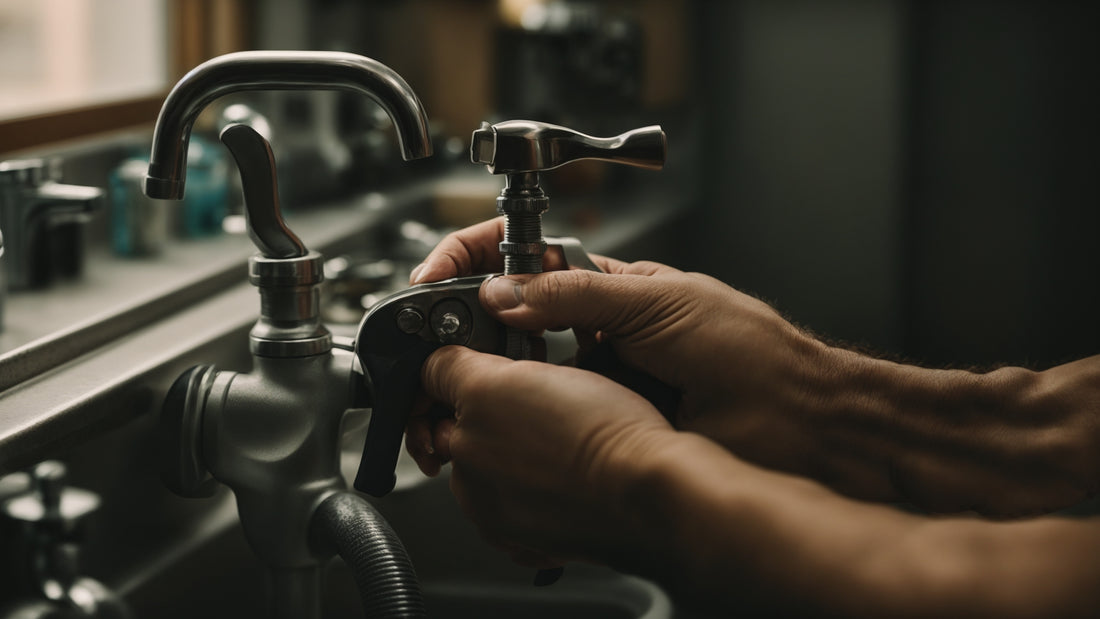10 Easy Steps to Fix a Leaky Faucet

Share
Drip, Drip, Drip: An Easy Guide to Fixing a Leaky Faucet
The incessant drip, drip, drip of a leaky faucet can be more than just an annoyance. It can also waste water and money, especially if left unaddressed. But don't worry, fixing a leaky faucet is usually a quick and easy job that even DIY novices can tackle.
In this blog post, we'll walk you through the steps of fixing a leaky faucet, no matter what type of faucet you have. We'll also provide some tips on how to prevent leaks in the future.
Before You Begin

Before you start, there are a few things you'll need to gather:
- A bucket or pan to catch any water that spills out
- A wrench (adjustable or the size specific to your faucet)
- Screwdrivers (flathead and Phillips)
- Paper towels
- Replacement parts (if necessary)
You can usually find replacement parts at your local hardware store. If you're not sure what parts you need, take the old parts with you to the store and ask for help.
Types of Faucets
There are two main types of faucets: compression faucets and cartridge faucets.
- Compression faucets have two handles, one for hot water and one for cold water. The leak is usually coming from the packing nut, which is the nut that holds the stem in place.
- Cartridge faucets have a single handle that controls both hot and cold water. The leak is usually coming from the cartridge itself.
Fixing a Leaky Compression Faucet

- Turn off the water supply. There should be two shut-off valves under the sink, one for hot water and one for cold water. Turn the valves clockwise until they stop.
- Open the faucet to release any pressure.
- Place the bucket or pan under the faucet.
- Remove the handle. There is usually a small cap on the top of the handle. Pry off the cap with a screwdriver and then unscrew the handle.
- Unscrew the packing nut. Use the wrench to loosen the packing nut counterclockwise. Be careful not to over-loosen it, or you could damage the faucet.
- Replace the washer. The washer is a small rubber ring that sits inside the packing nut. Remove the old washer and replace it with a new one.
- Tighten the packing nut. Use the wrench to tighten the packing nut clockwise, but don't over-tighten it.
- Reattach the handle. Screw the handle back on and tighten the cap.
- Turn on the water supply. Turn the shut-off valves counterclockwise until they stop.
- Turn on the faucet and check for leaks. If the faucet is still leaking, repeat steps 5-8.
Fixing a Leaky Cartridge Faucet
- Turn off the water supply. There should be two shut-off valves under the sink, one for hot water and one for cold water. Turn the valves clockwise until they stop.
- Open the faucet to release any pressure.
- Place the bucket or pan under the faucet.
- Remove the handle. There is usually a small cap on the top of the handle. Pry off the cap with a screwdriver and then unscrew the handle.
- Remove the cartridge clip. The cartridge clip is a small metal clip that holds the cartridge in place. Use the screwdriver to remove the clip.
- Pull out the cartridge. The cartridge is a cylindrical piece of metal that sits inside the faucet body. Pull the cartridge straight out of the faucet body.
- Replace the cartridge. Insert the new cartridge into the faucet body. Make sure that the cartridge is aligned correctly.
- Reattach the cartridge clip. Use the screwdriver to reattach the cartridge clip.
- Reattach the handle. Screw the handle back on and tighten the cap.
- Turn on the water supply. Turn the shut-off valves counterclockwise until they stop.
- Turn on the faucet and check for leaks. If the faucet is still leaking, replace the cartridge again.
Also Read: 5 Steps to Easily Replace Your Kitchen Faucet
Tips for Preventing Leaks
- Don't overtighten the faucet handles. Overtightening can damage the faucet and lead to leaks.
- Use the right tools. When repairing your faucet, use the right size wrench and screwdriver to avoid damaging the parts.
- Replace worn-out parts. If the faucet is leaking because of worn-out parts, replace the parts with new ones.






